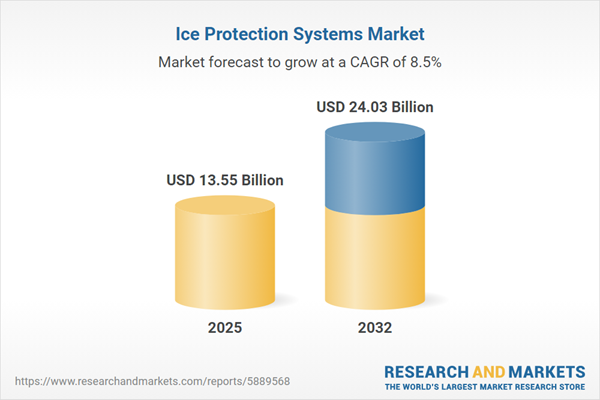Speak directly to the analyst to clarify any post sales queries you may have.
Aviation leaders navigating varying climates and compliance requirements are increasingly prioritizing robust ice protection systems to ensure fleet reliability. As regulatory complexity grows and operational demands diversify, advanced technologies and adaptable integration methods now define competitive positioning in the ice protection systems market.
Market Snapshot: Ice Protection Systems Market Size & Growth Outlook
The global ice protection systems market is experiencing consistent growth, fueled by rising compliance obligations and strategic investment from both commercial and defense aviation. By 2024, the market reached USD 12.51 billion, propelled by a compound annual growth rate (CAGR) of 8.50%. Fleet modernization programs, targeted retrofitting, and increased focus on operational durability continue to drive momentum into 2025. Original equipment manufacturers and maintenance, repair, and overhaul providers are leveraging flexible designs to address shifting regulatory landscapes and unique operational needs, facilitating further innovation in ice protection solutions.
Scope & Segmentation: Ice Protection Systems Market
- System Types: Bleed air, electrothermal, hybrid, and pneumatic boot systems provide specialized performance, allowing targeted thermal management across a variety of mission profiles and weather conditions.
- Aircraft Types: Business jets, commercial airplanes, helicopters, and military platforms each require tailored ice protection approaches to maintain mission capability and regulatory alignment.
- Technology Types: Optical, resistive, ultrasonic, and vibrational detection technologies offer early ice identification, supporting safe and compliant flight operations.
- Distribution Channels: Direct installations by OEMs and services from authorized and independent MRO networks ensure wide-reaching access to integration, upgrades, and replacement systems for operators globally.
- End-Users: Cargo carriers, passenger airlines, general aviation operators, pilot training organizations, private owners, and defense agencies all depend on robust ice protection for continuous safety and mission readiness.
- Geographic Coverage: Adoption trends are shaped by regional climate, compliance regimes, and aviation infrastructure, with noticeable variations in demand across the Americas, Europe, Middle East & Africa, and Asia-Pacific.
- Companies Profiled: The market landscape is influenced by major industry contributors including Raytheon Technologies Corporation, Honeywell International Inc., Parker-Hannifin Corporation, Eaton Corporation PLC, Meggitt PLC, Liebherr-International AG, and Saab AB, all shaping ongoing technical standards and development.
Key Takeaways Shaping the Ice Protection Systems Market
- Modular designs in ice protection are supporting streamlined certification efforts and simplifying fleet lifecycle management for operators managing both new and legacy assets.
- Integration of advanced sensors with networked monitoring platforms is improving real-time maintenance processes, enabling data-driven performance management and predictive operational planning.
- Electrothermal and hybrid systems are being favored for emerging aircraft models, while pneumatic boot systems remain a cost-effective upgrade pathway for existing fleets.
- Regional nuances highlight the influence of local climate conditions and evolving regulatory frameworks on modernization and system integration strategies.
- Collaboration between OEMs, integrators, and suppliers is enhancing technology integration and smoothing the process of retrofitting across mixed fleet types.
Tariff Impact on Supply and Competitive Positioning
New tariff measures on aerospace components in the United States have prompted manufacturers to reevaluate sourcing strategies and manufacturing locations. This shift supports a more resilient supply chain and drives increased focus on domestic supplier relationships. Enhanced supply chain management practices are proving essential for managing cost changes and ensuring continued competitiveness in both established and developing regions.
Methodology & Data Sources
The market findings are based on direct interviews with senior OEM leaders, insights from integration specialists, and input from key maintenance, repair, and overhaul entities. Analysis is further supported by sector-wide surveys and a comprehensive literature review, with scenario workshops providing real-world context for compliance and technology shifts.
Why This Report Matters for Aviation Decision-Makers
- Enables aviation executives to identify and deploy ice protection solutions that reinforce regulatory compliance and efficient operations in variable market contexts.
- Delivers actionable insights for selecting the right suppliers and technologies for regional and global operational requirements.
- Supports strategic planning around system integration and compliance readiness, maintaining reliable performance as business and regulatory conditions evolve.
Conclusion
This report equips senior aviation stakeholders with a structured framework for resilient ice protection strategies, focusing on advancing technologies, compliance, and operational goals in a changing global environment.
Additional Product Information:
- Purchase of this report includes 1 year online access with quarterly updates.
- This report can be updated on request. Please contact our Customer Experience team using the Ask a Question widget on our website.
Table of Contents
3. Executive Summary
4. Market Overview
7. Cumulative Impact of Artificial Intelligence 2025
Companies Mentioned
The companies profiled in this Ice Protection Systems market report include:- Raytheon Technologies Corporation
- Honeywell International Inc.
- Parker-Hannifin Corporation
- Eaton Corporation PLC
- Meggitt PLC
- Liebherr-International AG
- Saab AB
Table Information
| Report Attribute | Details |
|---|---|
| No. of Pages | 190 |
| Published | October 2025 |
| Forecast Period | 2025 - 2032 |
| Estimated Market Value ( USD | $ 13.55 Billion |
| Forecasted Market Value ( USD | $ 24.03 Billion |
| Compound Annual Growth Rate | 8.5% |
| Regions Covered | Global |
| No. of Companies Mentioned | 8 |









